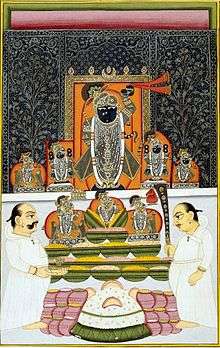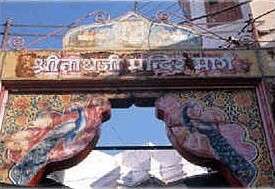Shrinathji Temple
| Shrinathji Temple, Nathdwara | |
|---|---|
|
Gate of the temple | |
| Geography | |
| Country | India |
| State | Rajasthan |
| Location | Nathdwara |
| Culture | |
| Primary deity | Shrinathji (form of Krishna) |
| History and governance | |
| Date built | 1672 |
| Creator | Goswami priests |
| Website | http://www.nathdwaratemple.org/ |
Shrinathji Temple is a hindu temple dedicated to Shrinathji in Nathdwara.[1] It is considered an important pilgrimage centre by Vaishnavs.[2]
Legend and History:-

The Swarup or divine form of Shrinathji is said to be self-manifested.[3] The idol of the Lord Krishna was moved during the late 17th century to what is now known as Nathdwara, Rajasthan from Govardhan during a time of social and economic upheaval in the region. When the idol reached the spot at village Sihad or Sinhad, the wheels of bullock cart in which the idol was being transported sank axle-deep in mud and could not be moved any farther. The accompanying priests realised that the particular place was the Lord's chosen spot and accordingly, a temple was built there under the rule and protection of the then Maharana Raj Singh of Mewar.[4] Shrinathji Temple is also known as 'Haveli of Shrinathji’ (mansion).[5] The temple was built by Goswami priests in 1672.[6]
Legend
According to the hagiography of the Pushtimarg, Shrinathji used to travel to Mewar to play chaupar (an antecedent to Parcheesi) with a Princess by the name of Ajab Kunvari. She was upset whenever her beloved Shrinathji would go back to Vraj and asked him to stay with her in the palace. Lord Shrinathji said that one day, when the time was right, he would re-locate to Rajasthan.
Presently, Shrinathji's worship is performed by direct male descendants of Vallabhacharya in a haveli (lit. palatial home) in Nathdwara, Rajasthan.
Economy and livelihoods in Nathdwara town revolve around the Haveli, the term used for the temple probably because it was situated in a fortified mansion, or Haveli, once a royal palace of the Sesodia Rajput rulers of Mewar.
Shrinathji was quite popular with other medieval devotees, as well, as there were preachers who founded Shrinathji temples in present-day Pakistan (Dera Ghazi Khan). This was done by Shri Lalji Maharaj and his deity of Shri Gopinathji and Shri Dauji of Dera Ghazi Khan, earlier a part of undivided India and not far from here. Shrinathji was even worshiped as far away as Russia (in the lower Volga region) and other places on the Central Asian trade routes. Tradition holds that Shrinathji would return to Govardhan some day with a new temple at Puchri in Govardhan.
Structure and Design of the Temple:-
The temple has been designed in the lines of temple of Nanda Maharaj (Krishna’s father), in Vrindavan. Therefore, it is also known as Nanda Bhavan or Nandalaya (the House of Nanda).
Structurally, a kalasha on the shikhara marks the top of the temple, on which seven flags are flown along with the Sudarshana Chakra. The seven flags represent the 7 'houses' of Pushti Marg or Vallabh Sampradaya. The temple is also popularly called Shrinathji ki Haveli (House of Shrinathji). With the mood of worship in Pushti Marg, Shrinathji is not seen as an impersonal God so the worship is not done like in a temple. Shrinathji is seen as Thakorji or Lord of the House or Haveli and Sewa (service) is offered rather than worship. Like a regular household it has a chariot for movement (In fact the original chariot in which Shrinathji was brought to Singhar), a store room for milk (Doodhghar), a store room for betel (Paanghar), a store room for sugar and sweetmeats (Mishrighar and Pedaghar), a store room for flowers (Phoolghar), a functional kitchen (Rasoighar), a jewellery chamber (Gahnaghar), a treasury (Kharcha bhandaar), a stable for horses of chariot (Ashvashala), a drawing room (Baithak), a gold and silver grinding wheel (Chakki).
The Nathdwara temple has subsidiary temples dedicated to deity Madan Mohan and Naveet Priya, located in the main complex.
The Image of Shrinathji
Shrinathji symbolizes a form of Krishna, when he lifted the Govardhan hill, with one arm raised.[7] The image in the form of a single black marble,[1] where the lord is revealed with his left hand raised and the right hand made into a fist resting at the waist, with a large diamond placed beneath the lips. The idol is carved in Bas-relief out of a monolithic black marble stone, with images of two cows, one lion, one snake, two peacocks and one parrot engraved on it and three sages placed near it.[8]
The iconography at the temple has given birth to Nathdwara Paintings.[2]
Festivals and Rituals at the Temple
Devotees throng to the shrine in large numbers during occasions of Janmashtami and other festivals, like Holi and Diwali. The deity is treated like a living image, and is attended with daily normal functions, like bathing, dressing, meals called "bhog" and the resting times in regular intervals. Since, the deity is believed to be the infant Krishna, accordingly, special care is taken. The priests in all Havelis are Brahmins under the Guru's who are the kul (descendants) of Vallabhacharya, the founder of this deity's idol at Govardhan hill, near Mathura.
The main attractions are the Aartis and the Shringar, i.e. the dressing and beautifying of the idol of Shrinathji which changed seven times daily, treating it as a living person, adorning it with the appropriate dresses for the time of day or night. The intricately woven shaneels and silk clothe have original zari and embroidery work on them, along with large quantities of real precious jewellery. The formal prayers are offered with diya, incense sticks, flowers, fruit and other offerings, with local instruments and devotional songs of the Shrinathji, according to the demand of the time and occasion. The view of the idol after the parda (curtain) is removed is called jhakhi.[9]
The Official Website of Shrinathji Temple Nathdwara
References
- 1 2 "Temple of Doodh". The Economic Times. 15 August 2002. Retrieved 2 April 2012.
- 1 2 Jain, Kajri (2007). Gods in the bazaar: the economies of Indian calendar art. Duke University Press. p. 86. ISBN 0822339269.
- ↑ Kapoor, Subodh (2002). The Indian Encyclopaedia: Meya-National Congress (Volume 16). Genesis Publishing Pvt Ltd. p. 5140. ISBN 8177552732.
- ↑ Roma Bradnock, Robert Bradnock (2001). Rajasthan & Gujarat handbook: the travel guide. Footprint Travel Guides. p. 203. ISBN 190094992X.
- ↑ "VISUAL ARTS: Textiles for the delight and delectation of the faithful". Tribune (magazine). 5 March 2009. Retrieved 2 April 2012.
- ↑ "Celebrating Nathdwara paintings". Times of India. 30 November 2008. Retrieved 2 April 2012.
- ↑ "Krishna conscious". The Financial Express. 26 June 2005. Retrieved 2 April 2012.
- ↑ "Nathdwar,Temple, Krishna, Rajasthan". Blessingsonthenet.com. Retrieved 20 November 2011.
- ↑ "The quest to reach God". Daily News and Analysis. 6 March 2008. Retrieved 2 April 2012.
Coordinates: 24°55′44″N 73°48′54″E / 24.9289935°N 73.8150981°E
